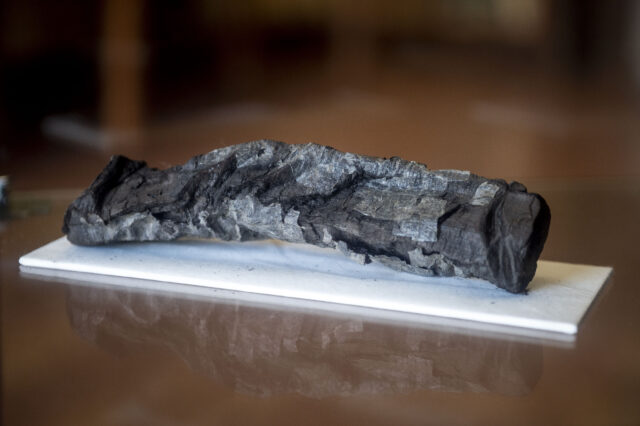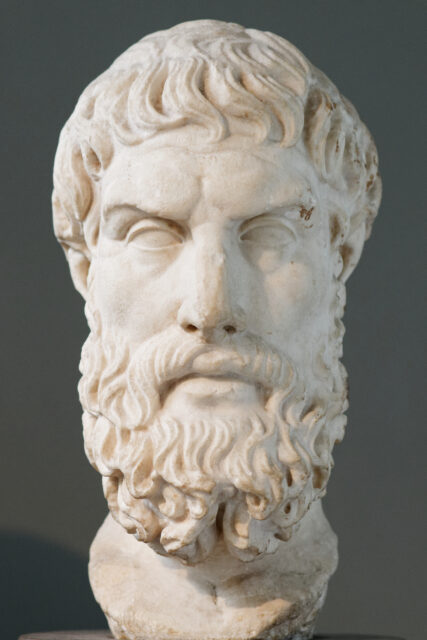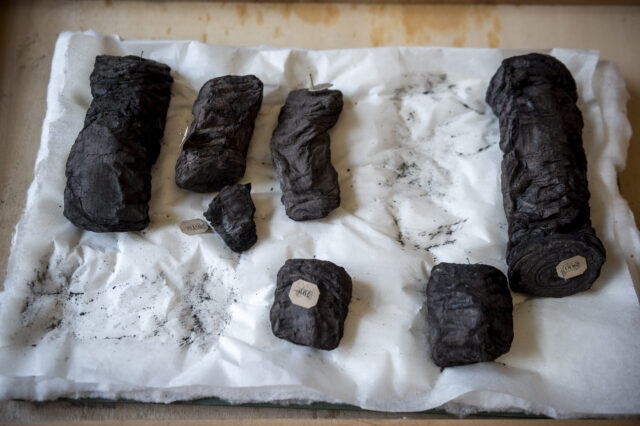These days, artificial intelligence is being utilized for practically everything. Unfortunately, experts in history and archaeology may not be well-versed in the world of AI. So, to attract the tech-savvy to help implement AI practices in their own research, a pair of researchers developed the Vesuvius Challenge in the hopes of using AI to do the impossible – decode charred ancient Greek scrolls without touching them.
The Vesuvius Challenge

A luxury Roman villa in Herculaneum, believed to have belonged to Julius Caesar’s father-in-law and housing hundreds of papyrus scrolls, was burned to a crisp following the devastating eruption of Mount Vesuvius in 79 AD. Over 1,000 rolled-up whole or partial Greek scrolls were carbonized during the eruption, making them look like logs of hardened ash. When excavations of the area began in the 18th century, the scrolls were in such delicate condition that they would crumble when researchers tried to open them and what black ink was visible was virtually unreadable. Since then, the scrolls have remained rolled up at the Institut de France in Paris and the National Library of Naples.
The Vesuvius Challenge was launched in 2023 and was developed by Brent Seales, a computer scientist at the University of Kentucky, and Nat Friedman, the founder of Github, requiring contestants to decipher four passages of one of these Herculaneum scrolls, identifying at least 140 characters with at least 85 percent of characters recoverable. Providing high-resolution CT scans of the scroll, the pair backed the challenge with a $1 million prize to help motivate researchers.
The team of researchers who cracked the code

Friedman announced that a team of three researchers won the $700,000 grand prize after they read more than 2,000 Greek letters from the scroll. Luke Farritor, a student and SpaceX intern from Nebraska, previously won the challenge’s $40,000 “first letters” prize after identifying the word “purple” in the Greek scroll. Following this, he teamed with Youssef Nader, a Ph.D. student in Berlin, and Julian Schilliger, a Swiss robotics student, to try and win the contest.
The team built off of the algorithms developed and released by Seale to digitally unwrap the scroll and detect ink on its surface. Together, they were able to identify more than 2,000 letters, about five percent of the scroll, which is an incredible feat. “It’s been an incredibly rewarding journey,” Nader said. “The adrenaline rush is what kept us going. It was insane. It meant working 20-something hours a day. I didn’t know when one day ended and the next day started.”
Robert Fowler, emeritus professor of Greek at Bristol University and chair of the Herculaneum Society, said that their work “is a complete gamechanger” for the professions, as there are “hundreds of these scrolls waiting to be read.” Dr Federica Nicolardi, a papyrologist at the University of Naples Federico II, said, “This is the start of a revolution in Herculaneum papyrology and in Greek philosophy in general. It is the only library to come to us from ancient Roman times.”
The content of the scroll

This contest has allowed researchers to determine the contents of the scroll. The passage that was revealed takes a philosophical approach to discussing the sources of pleasure, about whether pleasure is experienced from a combination of elements owes to the major or minor constituents, the abundant or the scarce. The passage discusses pleasure in the form of food and music.
“It probably is Philodemus,” Fowler said of the scroll’s author. “The style is very gnarly, typical of him, and the subject is up his alley.” The author wrote, “In the case of food, we do not right away believe things that are scarce to be absolutely more pleasant than those which are abundant.” Fowler contemplated this passages, saying, “I think he’s asking the question: what is the source of pleasure in a mix of things? Is it the dominant element, is it the scarce element, or is it the mix itself?”
Moving forward

The closing of the contest actually serves as the beginning of a new movement to read more of the Herculaneum scrolls. To start, the challenge and research will continue on the same scroll with the intent to have about 85 percent read. In doing so, it will lay a solid foundation for the deciphering of the hundreds of scrolls already discovered and waiting to be read, as well as the many more that are believed to still be buried at the villa. It is likely that more excavations will take place to recover them.
Read more: Colossus of Rhodes – The Ancient Wonder That Towered Over Greece
Next steps for researchers is to fully automate the tracing of the papyrus’s surface, as well as improve upon ink detected on the more damaged parts of the scrolls. “When we launched this less than a year ago, I honestly wasn’t sure it’d work,” Friedman said. “You know, people say money can’t buy happiness, but they have no imagination. This has been pure joy. It’s magical what happened, it couldn’t have been scripted better.”
